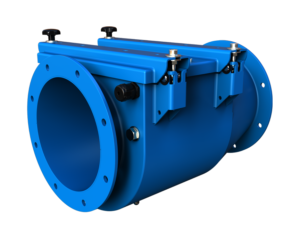Explosion Isolation Flap Valves
爆発しゃ断フラップバルブ

Types
| Process Equipment Protection Basis | Mechanical Isolation Guidelines |
| Containment | The mechanical isolation device applied must be designed to survive the maximum explosion pressure for the process material, Pmax. In addition, all of the piping and equipment upstream of the isolation device must also be designed to accept Pmax. This may require a design pressure as high as 230 psig (16 bar). |
| Venting | The mechanical isolation device applied must be designed to survive the reduced explosion pressure of a vented deflagration, Pred. In addition, all of the piping and equipment upstream of the isolation device must also be designed to accept Pred. This will typically require a design pressure as low as 3 psig (0.2 bar). |
| Suppression | The mechanical isolation device applied must be designed to survive the reduced explosion pressure of a suppressed deflagratlon, Pred. In addition, all of the piping and equipment upstream of the isolation device must also be designed to accept Pred. This will typically require a design pressure as low as 2 or 3 psig (0.14 or 2 bar). |
Sizing
| Normal Size | Low Pressure Isolation Valve | High Pressure Isolation Valve | |||
| in | mm | lbs | Kg | lbs | Kg |
|---|---|---|---|---|---|
| 4 | 100 | 57 | 26 | 150 | 69 |
| 6 | 150 | 96 | 44 | 195 | 89 |
| 8 | 200 | 151 | 69 | 305 | 140 |
| 10 | 250 | 297 | 136 | 415 | 190 |

Types
| Process Equipment Protection Basis | Mechanical Isolation Guidelines |
| Containment | The mechanical isolation device applied must be designed to survive the maximum explosion pressure for the process material, Pmax. In addition, all of the piping and equipment upstream of the isolation device must also be designed to accept Pmax. This may require a design pressure as high as 230 psig (16 bar). |
| Venting | The mechanical isolation device applied must be designed to survive the reduced explosion pressure of a vented deflagration, Pred. In addition, all of the piping and equipment upstream of the isolation device must also be designed to accept Pred. This will typically require a design pressure as low as 3 psig (0.2 bar). |
| Suppression | The mechanical isolation device applied must be designed to survive the reduced explosion pressure of a suppressed deflagratlon, Pred. In addition, all of the piping and equipment upstream of the isolation device must also be designed to accept Pred. This will typically require a design pressure as low as 2 or 3 psig (0.14 or 2 bar). |
Sizing
| Normal Size | Low Pressure Isolation Valve | High Pressure Isolation Valve | |||
| in | mm | lbs | Kg | lbs | Kg |
|---|---|---|---|---|---|
| 4 | 100 | 57 | 26 | 150 | 69 |
| 6 | 150 | 96 | 44 | 195 | 89 |
| 8 | 200 | 151 | 69 | 305 | 140 |
| 10 | 250 | 297 | 136 | 415 | 190 |






